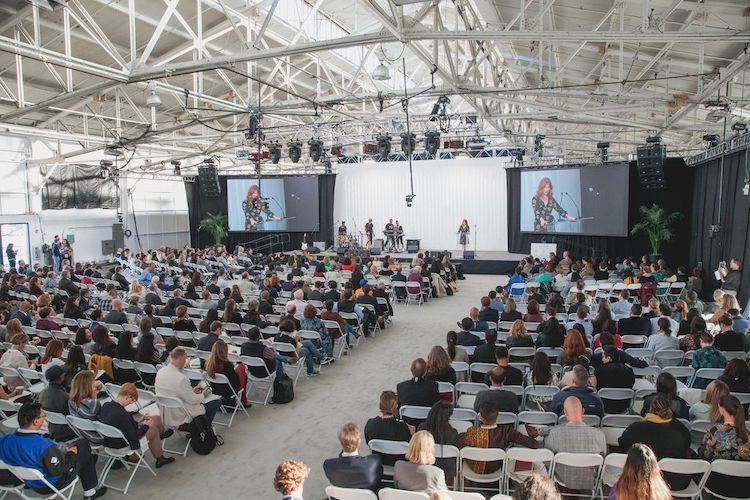San Francisco, CA – Agents of Impact are making news.
Seated next to Prime Coalition’s Sarah Kearney, Packard Foundation’s Susan Phinney Silver announced a commitment to the Prime Impact Fund for early-stage climate innovation. “Now is the time to be bold and really push ourselves to make new and different types of investments in our fight against climate change,” said Phinny Silver.
ImpactAlpha earlier broke news of the Packard and MacArthur foundations’ investments in the $90 million Terra Silva sustainable forestry fund, and dug into Rockefeller Foundation’s new role as an impact fund management, with $60 million for “Zero Gap” initiatives to meet the Sustainable Development Goals. Global Partnerships closed $55 million in financing for their Impact-First Development Fund, backed by family office Ceniarth, the W.K. Kellogg Foundation and OPIC.
Our team on the ground was boosted by fellows Shifali Gupta, Rohan Jha, and Bethany Wylie from the Kellogg School of Management, who fanned out to capture the big ideas of the day.
Capital being catalytic
Nearly all the deals that got done this week rely on the creative and flexible use of capital to jog nascent markets. That includes grants. “Catalytic philanthropy can mobilize a lot of capital with small amount of money,” said Jennifer Schorsch of Water.org, who called for funders and implementers to back solutions with customer input. “Your customers should participate in the solution.”
Panta Rhea Foundation’s Anna Lappé added, “We can use philanthropic dollars to beta test innovative interventions.” The biggest problem in the food system, she said: “democracy and access.”
The Rockefeller Foundation, on cue, announced a $2 million food system vision prize with SecondMuse and OpenIDEO to test solutions for regenerative and nourishing local food systems. – Bethany Wylie
Building markets
Agents of Impact are rewriting the rules of finance to unblock capital for underserved communities.
Habitat for Humanity is building a secondary market for affordable home mortgages, like its own 0% interest mortgages, to drive down lending costs for new homeowners. Habitat’s Daniel Gura explained, “Your ability to liquidate that asset if you need to, the ability to do trading, is what allows for better initial pricing.”
Students face a tuition gap of $5,000 to $15,000 per year on average. Nationally, “That’s a $70 billion problem per year,” said SixUp’s Sunwoo Hwang. Sixup’s “Future Prime” underwriting model focuses on student success and ability to repay, rather than their credit score. Online tutoring and job placement support “de-risks that person along the journey,” Hwang said. – Bethany Wylie
Measurement in practice
Investors are putting impact measurement and management tools to work (see, “IRIS+ tool provides guidance to reset expectations for ‘impact performance’”).
Project X Global, which works with corporations on sustainable supply chains, is using IRIS+ towards its goal of shifting 10% of global procurement to sustainable sourcing. Capria Ventures is using the metrics to build credibility of first-time fund managers in emerging markets. AlphaMundi Foundation uses more than 150 of the metrics to track the impact of investments in smallholder farmers, financial inclusion, renewable energy and women. – Rohan Jha
Changing the narrative
“We’re not talking about ‘closing the racial wealth gap,’ we’re talking about dismantling a racially exploitative economic system,” said Agent of Impact Rodney Foxworth of Common Future’s (formerly BALLE). See ImpactAlpha’s Q&A with Foxworth. – h/t Antony Bugg-Levine.
“I’ve become an evangelist in the locker room,” said KNGDM’s Derrick Morgan, who recently retired from the NFL to pursue impact investing (see, “Agent of Impact: Derrick Morgan of KNGDM Impact Fund.”). “I’d say, ‘Hey, I know you’re doing those football camps, but have you heard of impact investing?’”
Asked Morgan Simon of Oakland-based Candide Group, “How can we tell our kids that I made money for you by locking up another family or polluting the earth?”
Hunting for impact tech unicorns
Impact investors have long recognized the exponential possibilities in technology, but they still may have a thing or two to learn from tech venture capitalists.
“The vast majority of impact investors are very uncomfortable with a company that has only a 20% chance of succeeding, but if it succeeds, could eliminate an entire category of problems,” Fifty Years’ Seth Bannon told ImpactAlpha’s David Bank in a discussion of tech’s turn to impact.
“That’s a bet we would take all day long.” Maryanna Saenko of Future Ventures citing her firm’s investment in Commonwealth Fusion Systems. “If you can solve nuclear fusion, the market is there,” she says.
Both Bannon and Saenko are looking hard at carbon sequestration but haven’t placed any bets. “It can’t be a one to two percent improvement,” Saenko said. “It needs to be a 1,000X improvement.”
Next startup hubs
Long-standing tech hubs like San Francisco and New York have startup resources often in shorter supply in smaller cities: talent, capital, and well-developed ecosystems (see, “Creating physical spaces where innovation can flourish”). But a little goes a long way outside of the coastal hotspots.
“It may be harder to find pieces to make a robust ecosystem in a mid-size city, but it’s easier to assemble it,” said Bush Foundation’s Allison Barmann. The foundation is putting Minneapolis on the map as a hub for social entrepreneurs and Native founders —Shifali Gupta
Workforce tech
It seems like everyday a new coding bootcamp is raising funding. There are as many as 1,000 bootcamps around the country, according to Jason Palmer of New Markets Ventures. “Demand for tech jobs has reached all the way down to third grade.”
Elizabeth Garlow of Lumina Foundation called for the U.S. to reexamine an old workforce training model: apprenticeships. “Other places in the world understand their role and value.”—Rohan Jha
Tech-enabled democracy
The flip-side to technology’s role in election interference and the spread of misinformation could be civic engagement and stronger democratic institutions. Long-term thinking is crucial, argued Allen Kramer of MobilizeAmerica.
“Every presidential cycle, there are tools built that die after the election. We’re thinking about everything we can do in 2020, but also building long-term infrastructure.”—Bethany Wylie
Bridging the gap
Finance touches everything, so social justice activists need to master it. “Top down is important,” said Transform Finance’s Andrea Armeni in a conversation about the future of capitalism. “The bottom-up needs to be combined with the levers of power that can actually do something about it.”
Fran Seegull of U.S. Impact Investing Alliance calls it “subverting from the center.”











